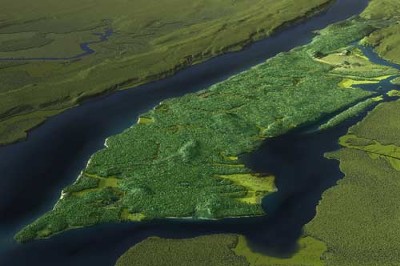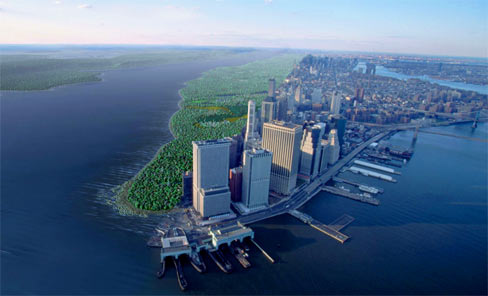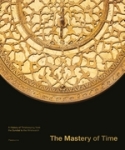
If the lush green island above looks strangely familiar, that’s because you’ve undoubtedly seen it many times before. Although if you’re having trouble placing just how you know this beautiful wild landscape, that’s because you’re probably used to seeing it look more like this:

Of course you know that the second picture is Manhattan Island as it looks today, the bustling hub of New York City. But the first picture above is the same island, Mannahatta or “Island of Many Hills,” (as it was called by local Native Americans) circa 1609.
For the past ten years the scientific researchers at the Mannahatta Project have been painstakingly recreating what the island would have looked like prior to the arrival of Henry Hudson and his crew on September 12, 1609. When the New World came calling, the island of Mannahatta was an amazingly diverse and abundant natural landscape, with more ecological communities, plant species, and birds than today’s Yellowstone, Yosemite, and Great Smoky Mountains National Parks. In addition to housing numerous large mammals, fish, and other wildlife, the island was also home to the Lenape tribe of people. In the 400 years since Hudson’s arrival, Mannahatta gave way to Manhattan, cultural diversity replaced biodiversity, and economic wealth replaced ecological wealth as the land that once existed was rendered virtually unrecognizable. Until now, that is. Over the past decade, the Mannahatta Project has been digitally rebuilding the land of yesterday by analyzing soil records, geography, rivers and wetlands, maps, descriptions of long disappeared plant and animal life, as well as by studying the landscape of the island today. The project is extensive in its research and astounding in its results.

You can explore the island past and present in extensive detail in the new book Mannahatta: a Natural History of New York City. Inside you’ll find a full explanation of the science behind the project, detailed descriptions of just what the researchers discovered about the island, and a look forward to what Manhattan might look like 400 years from now. All of this is accompanied by numerous stunning illustrations of what the researchers believe Mannahatta to have looked like long ago, as well as amazing side by side comparisons of various spots around the city as they look now and how they would have appeared in 1609.
And for a more distilled and interactive look at the project, check out the very cool Mannahatta Project website. As the project researchers believe, by looking backwards into the past, perhaps we can glimpse a new ecological vision for the future.
 Dr. Thomas Simpson is a Distinguished Senior Lecturer in Italian at Northwestern University and the author of the recent book Murder and Media in the New Rome: The Fadda Affair. Meticulously researched in the libraries and archives of Italy, his book offers a fascinating exploration of “a sensational crime and trial that took place in Rome in the late 1870’s, when the bloody killing of a war hero triggered a national spectacle.” On Thursday, January 31st at 7 p.m., you can hear Dr. Simpson discuss and read from Murder and Media in the New Rome when he visits EPL’s 1st Floor Community Meeting Room as part of the Evanston Northwestern Humanities Lecture Series. In anticipation of his visit, we recently spoke with him via email about how the Fadda Affair fits into the whole of Italian history, how newspapers helped enflame the scandal, the role of Roman women in the spectacle, and the best novels about the “Risorgimento” period.
Dr. Thomas Simpson is a Distinguished Senior Lecturer in Italian at Northwestern University and the author of the recent book Murder and Media in the New Rome: The Fadda Affair. Meticulously researched in the libraries and archives of Italy, his book offers a fascinating exploration of “a sensational crime and trial that took place in Rome in the late 1870’s, when the bloody killing of a war hero triggered a national spectacle.” On Thursday, January 31st at 7 p.m., you can hear Dr. Simpson discuss and read from Murder and Media in the New Rome when he visits EPL’s 1st Floor Community Meeting Room as part of the Evanston Northwestern Humanities Lecture Series. In anticipation of his visit, we recently spoke with him via email about how the Fadda Affair fits into the whole of Italian history, how newspapers helped enflame the scandal, the role of Roman women in the spectacle, and the best novels about the “Risorgimento” period.




